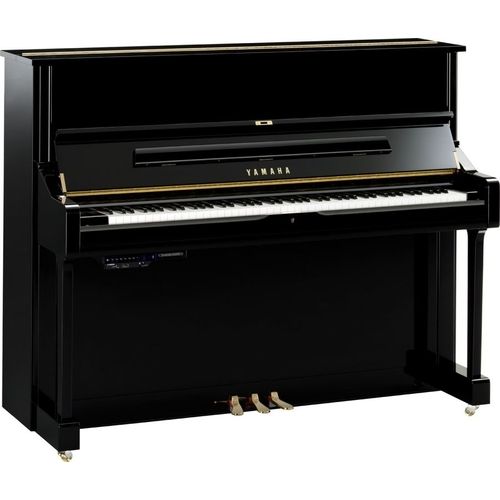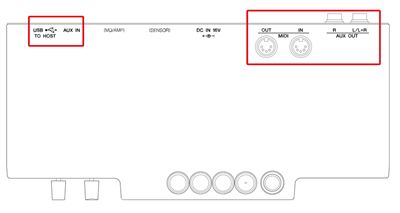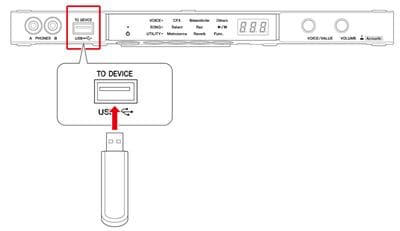Yamaha U1TA2 TransAcoustic Upright Piano
The Yamaha U1TA2 TransAcoustic Upright Piano is finally here. You really have to come and hear this amazing instrument. The internet is just not up to telling you what this is like. Check it out at Park Pianos Perth shop
Stock is a problem with these pianos because of the Computer Chip shortage.
Please call the shop to check availability
Yamaha U1TA2 TransAcoustic Upright Piano at Park Pianos
Yamaha U1TA2 TransAcoustic Upright Piano in Perth
Yamaha U1TA2 TransAcoustic Upright Piano at Music Park
A perennial favorite among discerning pianists, the Yamaha U1 offers outstanding musical performance, setting the standards by which many other upright pianos are measured. TransAcoustic™ functionality has been added to this U1.
This is a TA2 type TransAcoustic™.
I downloaded the info on this piano from Yamaha's website and it is below, but it does not really do justice to what this amazing instrument is, so I thought I should write something myself:
Many years ago, Yamaha decided to make what they ended up calling a Silent PIano. It is a fully acoustic piano that can be put into a mode where the hammer does not touch the strings and you hear the sound of a piano in your headphones. Hence, silent for anyone else in the room.
This was great and for quite a few years, this is where development stopped. Next Yamaha developed Level 2 Silent pianos. This was not a huge change, but among other things, you can now choose the type of sound you hear in the headphones. Could be a different type of piano, or an electronic piano, or strings or choir or harpsichord, or.. or...This gave us some interesting sounds to use when we played. Yamaha then developed Trans Acoustic Pianos.
This is a MAJOR change which takes a bit to explain - Instead of the sound of the piano, or whatever sound you choose going to headphones, they wanted it to be able to be heard along with the natural acoustic sound of the piano at the same time. Perhaps the piano with string or choir backing. Perhaps a piano with electronic piano together. Perhaps the piano (acoustic) plus a grand piano giving a much better bottom end than the upright by itself.
They did not want to just plug in speakers, which can already be done with the Silent Pianos. They wanted the extra sounds to actually come off the soundboard of the piano. To achieve this they put 2 amplifiers inside the piano, but instead of adding speakers, they attached 2 speaker transducers to the soundboard of the piano.
They did not want the heavy speaker magnets attahced to the soundboard, so they are attached to the frame, allowing the soundboard to vibrate freely. The result is amazing. The extra sounds actually come off the soundboard of the piano, so it just sounds real, even though it's not. You can leave the piano in silent mode and just use the Trans Acoustic sounds by them selves, or you can have the sound of the piano itself with Trans Acoustic sounds added over the top.
It is stunning!!! One thing I did when I first tried it was amazing. I put the piano in Trans Acoustic Mode, with amps on, selected a piano and hit a big chord. Then I put it in Silent Mode and turned off the Trans Acoustic Mode as well. There is now no acoustic sound coming from the Sound Board, as it dies as soon as silent mode is engaged.
All you can hear is the resonance of the strings, which are vibrating in sympathy with the sound that has just been stopped. Digital pianos have had "String Resonance" for years. This is what it REALLY is. The various combinations are amazing.
Understanding that this new model, the Yamaha U1TA2 now retails for only $1,000 more than a Silent Piano, it is quite simply outstanding value.
When Yamaha first showed it to us, the prices were not set but they anticipated it being $4,000 more than the Silent. All I can assume is, they want to sell a lot of Trans Acoustic Pianos, because for that small upgrade, I cannot see me selling too many Silent Pianos.
Come in and check out this amazing instrument. You will be amazed
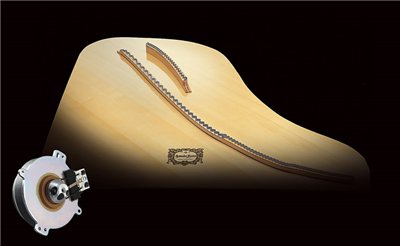
Newly developed TransAcoustic™ technology transmits digital sound directly to the piano soundboard, thus making the piano itself behave as a speaker. On a TransAcoustic™ piano, the sound that you hear is resonating directly from the soundboard. The tone generator sends an optimized audio signal to transducers that are connected by a coil to the soundboard. This sets the coils in motion, causing the soundboard to vibrate and generate sonic vibrations that travel through bridges attached to the soundboard, and are ultimately transmitted to the strings, making them resonate with sound.
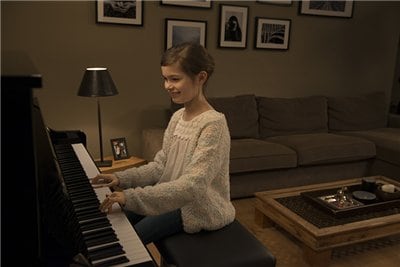
There are times when the full sound of an acoustic piano may not be appreciated by your family or neighbors. For these situations, simply activate the TransAcoustic™ mode and the hammers will no longer strike the strings. Non-contact sensors under each individual key detect your keystroke depth, velocity and timing and send this information to the tone generator. Just adjust the volume and hear the digital sound of your piano performance coming from the entire instrument. Naturally, there is no need for headphones or external amplification.
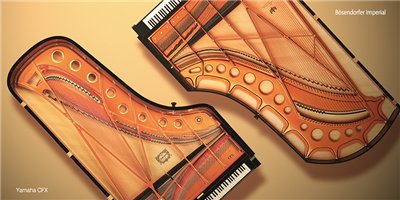
You can play TransAcoustic™ TA2 type with the voices of CFX, Yamaha’s finest concert grand piano, and Bösendorfer’s legendary Imperial. All 88 keys are sampled individually. As Yamaha’s flagship grand piano, the majestic CFX boasts a wide palette of tonal colors, from sparkling high notes to powerful bass tones. The legendary Bösendorfer, meanwhile, is renowned for its sonorous and rich Viennese sound.
A broad sonic palette
TransAcoustic™ TA2 type offers total 20 pre-installed sounds such as electric pianos, harpsichord, organs, strings, choir, and synth pad, allowing you to select the ideal voice to match your preferred musical genre.
Combine acoustic and digital sound
Thanks to their unique construction, TransAcoustic™ TA2 type allow you to layer the natural, resonant sound of the acoustic piano together with voices from the tone generator. Perhaps the most scintillating sounds are created by combining the acoustic and digital properties of the instrument—for example, gentle orchestral strings seemingly played from an acoustic piano—to achieve sonic textures with a natural quality not found on any other instrument.
Play-along to music
Enjoy playing along with any of the 50 preset songs that come with TransAcoustic™ TA2 type, accompanying your playing with songs you have recorded yourself, or even with commercially available songs played back through the sound board. You can play a duet with yourself, or you can just sit back and listen to the playback.
Featuring SILENT Piano™ SH2
Yamaha's SILENT Piano™ SH2 technology allows practice sessions to be conducted with headphones. Yamaha's SILENT Piano™ SH2 technology also features a superb binaural sample from the Yamaha CFX concert grand piano recorded using special techniques to perfectly capture the sound from the player's natural listening position. These two technologies combine to create the perfect environment to play without disturbing others.
Rich resonance and subtle accurate reproduction
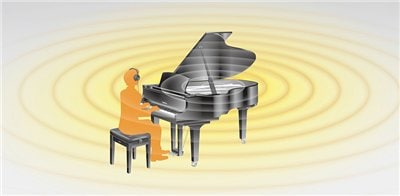
CFX Binaural Sampling *Only for SILENT Piano™ mode
Yamaha’s advanced binaural sampling technology uses samples from the CFX, Yamaha’s acclaimed concert grand piano, recorded with specialized microphones that capture locational information and other nuances discerned by the human ear. The resulting sound is so natural, so enveloping, that you’ll soon forget you’re even wearing headphones at all.
VRM physical modeling-—the distinctive reverberation generated by the entire body of a concert grand piano *Only for SILENT Piano™ mode
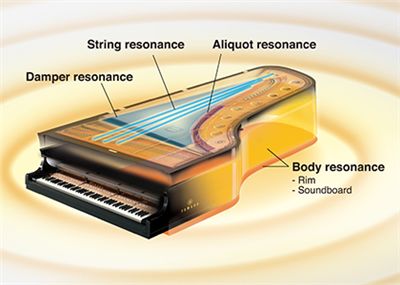
In a grand piano, sound resonates throughout the body of the instrument, producing a rich reverberation that envelops the listener in sound. This phenomena is reproduced perfectly through enhanced Virtual Resonance Modeling (VRM). The original VRM calculates the various states of the strings for each of the 88 notes on the keyboard, from one instant to the next, and timing and depth of damper pedals pressed. The enhanced VRM now also calculates aliquot resonance in the upper octaves, and the full resonance of the soundboard, rim, and frame. This technology allows for vivid, bright, richly-varied expression that reflects the limitless number of factors inherent in piano performance.
Stereophonic Optimizer (Piano Voices other than CFX Grand) *Only for SILENT Piano™ mode
Stereophonic Optimizer is an effect which reproduces the natural sound distance, like with the sound of Binaural Sampling, even though you are listening to it on headphones. When one of the Piano Voices other than CFX Grand is selected, the Stereophonic Optimizer is enabled.
Smooth Release-From staccato to legato, superbly expressive sound that responds to the player’s touch
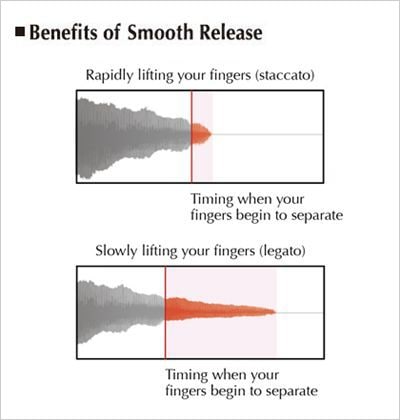
Featuring Yamaha's Smooth Release technology, TransAcoustic™ TA2 type offers the crisp tone heard when playing staccato as well as the lingering sound produced by releasing the keys more. This provides finely-nuanced response to the pianist’s playing.
Key-Off samples
The moment a pianist’s fingers are lifted from the keys of a grand piano, subtle changes occur in the instrument’s tone as the damper is lowered onto the strings to mute its sound. Key-Off samples features actual recordings of these changes, offering a faithful reproduction of the most subtle changes in the piano’s sound, allowing for a more realistic performance.
Unique Yamaha technology retains the all-important touch of the piano
Key sensors
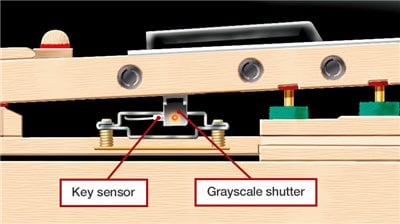
Under each of the 88 keys is a Yamaha-unique continuous-detection grey-scale shutter key sensor. These sensors detect the movement of the keys continually, allowing natural musical expression even when the piano is in TransAcoustic™ mode or SILENT Piano™ mode. Since they do not come into contact with the keys, these sensors do not affect the feel of the keyboard in any way.
Hammer sensors
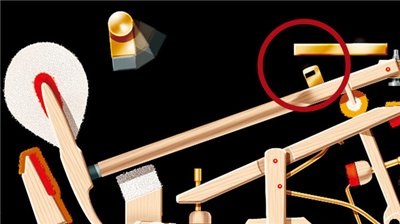
Grand piano with TransAcoustic™ TA2 type are fitted with hammer sensors that allow even slow keystrokes or rapid trills. To ensure that they do not affect the feel of the keyboard in any way, Yamaha uses non-contact sensors.
Quick escape system
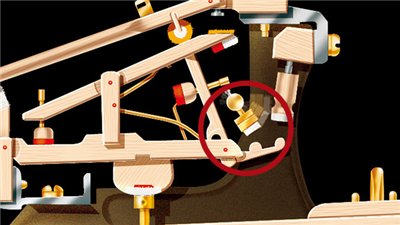
Grand piano with TransAcoustic™ TA2 type features a quick escape system that allows the sound muting mechanism to be fitted to a grand piano without sacrificing any of the playability or musical expression demanded of such instruments in an acoustic performance. This system allows optimal separation to be obtained between the hammers and strings by adjusting the distance between the hammers and strings, ensuring that the feel of the keyboard stays in the best possible condition whether playing acoustically or with the sound muted.
General functions
Connect wirelessly for Bluetooth® audio
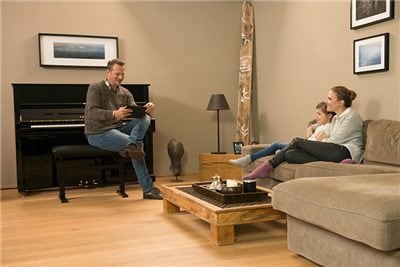
You can stream audio files through TransAcoustic™ TA2 type by using a Bluetooth-enabled smart device. You can enjoy playing along with any songs on your smart device. (May not be available depending on your area)
Smart Pianist APP
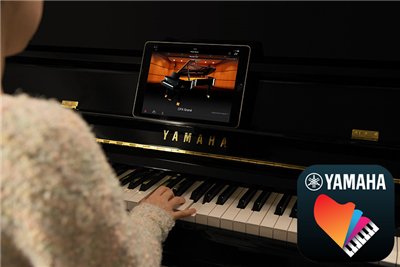
The smart device app “Smart Pianist” (available as a free download) enables you to use the functions such as selecting Voices, controlling the metronome intuitively with the visualized interface, or display the score on your smart device.
The UD-WL01 USB Wireless LAN Adaptor (sold separately) is required to use Smart Pianist over a wireless connection.
Sophosticated & simple design of the control panel
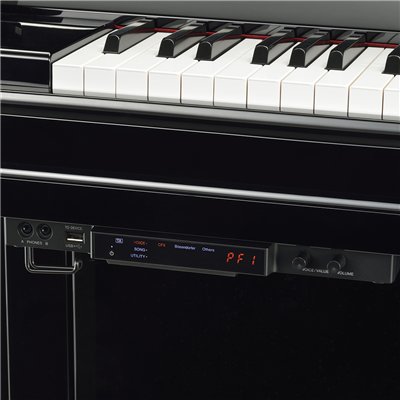
The control unit has been given a sophisticated design that unobtrusively blends with the piano itself. Moreover, the simple controllers allow you to operate the instrument easily.
Connection terminals
The USB TO HOST terminal allows you to connect to a computer or portable device and record high-quality audio without the need for an additional interface, while AUX OUT allows sound to be output to a variety of external devices (e.g. stereo components, IC recorders, speakers with built-in amplifiers, stereo systems), and AUX IN allows listening to sound from external devices (sound source modules and music players). MIDI OUTPUT transmits performance information to external devices such as synthesizers. MIDI IN allows the instrument to receive and playback performance information from sequencers using the tone generator of the TransAcoustic™ TA2.
Two recording systems (Built-in recorder and USB audio recorder)
The performance can be recorded in two different ways. It can be recorded either directly to the built-in recorder of a piano, or to a USB audio recorder, in which case the data stored in USB flash memory in WAV format can be played on a PC as well. Using a built-in recorder is more convenient if the players wish to listen to the recorded piece right away. It allows them to listen to the entire performance of a music piece or to go back and listen to a particular section of the piece. Since performances are saved in WAV format with a USB audio recorder, they can be recorded onto CDs or played on portable music players.
Open structured headphones- produce clear, high-quality sound
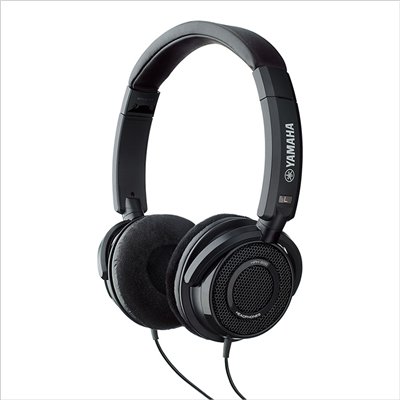
The headphones that come with TransAcoustic™ TA2 type are designed in a way that minimizes the strain on users after long hours of playing. This newly employed headphones contribute to the improvement of sound quality as well as to the reduction of fatigue during performance.
Metronome
TransAcoustic™ TA2 type has a built-in metronome that can be used in both TransAcoustic™ mode and SILENT Piano™ mode so that players can listen to precise rhythm while they play.
Park PIanos in Perth Western Australia carry the Yamaha U1TA2 in stock

